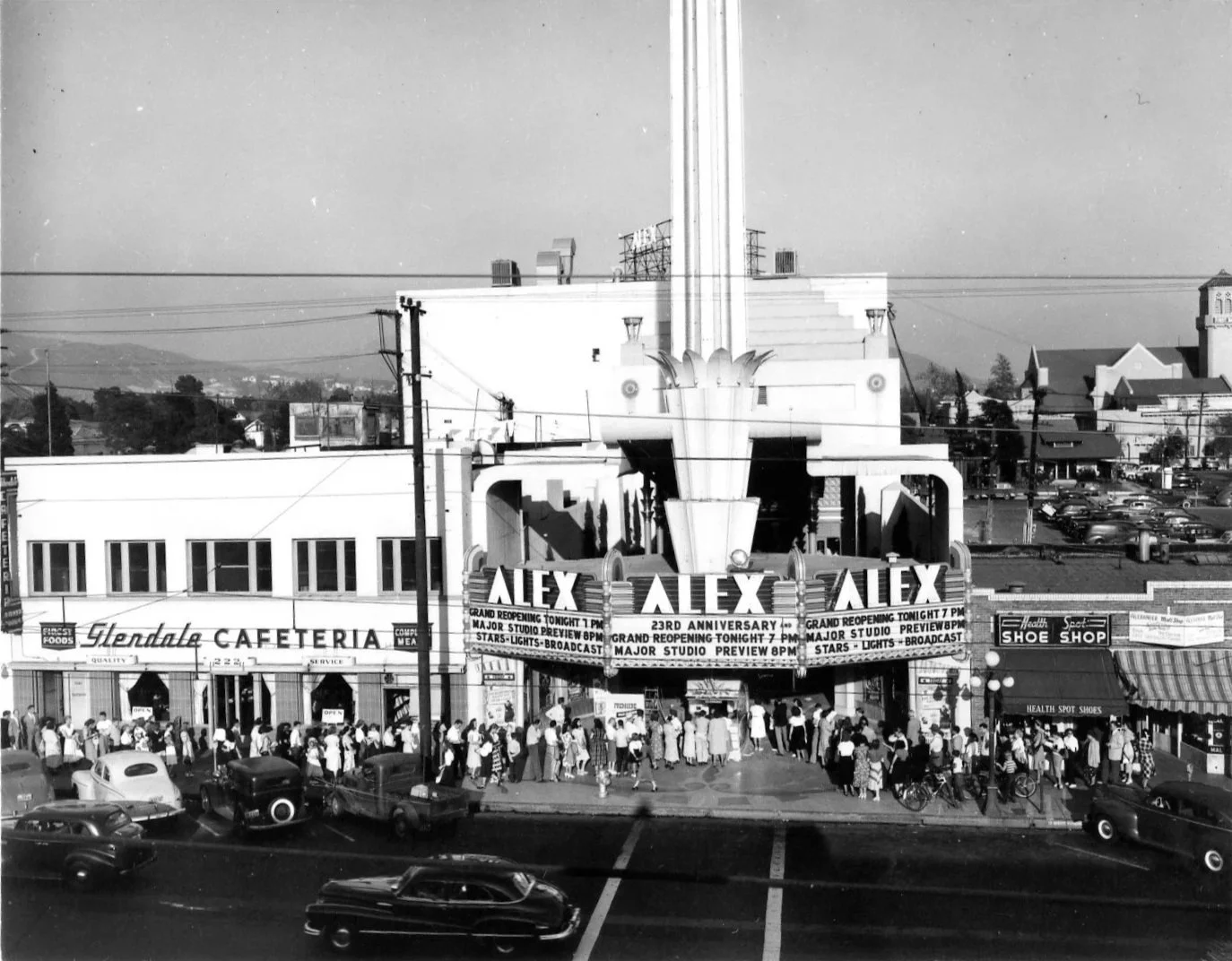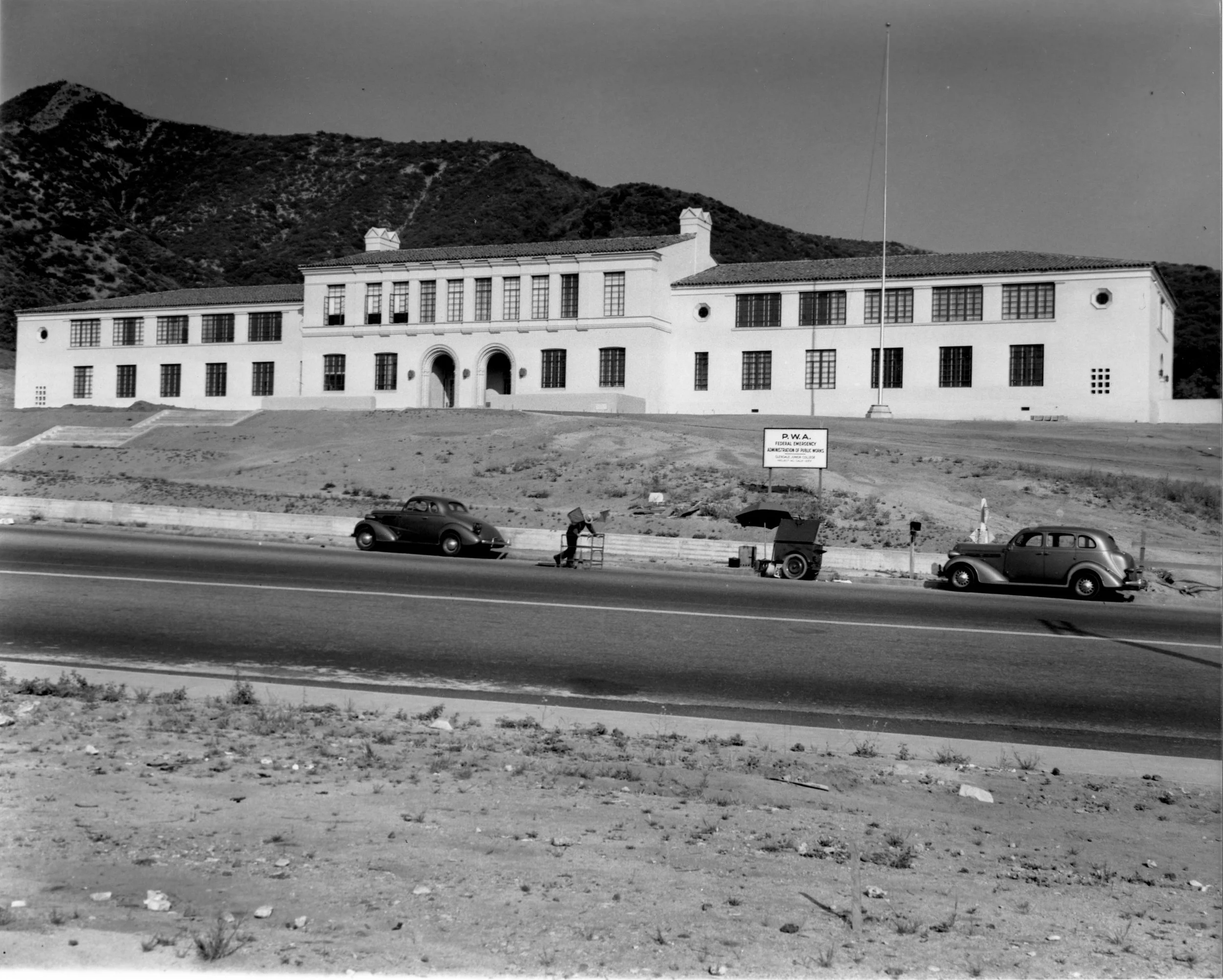Still Standing After all these Years
By Katherine Peters Yamada
Part 1: The Tongva, The Missions and the Verdugos
The land that is now Glendale was inhabited by the Tongva before the Portola expedition established a permanent Spanish presence in 1769. Two years later, Mission San Gabriel was founded.
Jose Maria Verdugo, a soldier at the mission, received title to Rancho San Rafael in 1797. His son Julio inherited, but in 1871 the land was lost due to bankruptcy proceedings. Two adobes built by Verdugo family members survive from that time and are now city parks.
Ramona and Frank Mendibles at the Verdugo Adobe on Bonita, May 1921, Courtesy of the Glendale History Room, Glendale Public Library
Spanish fiesta at Casa Adobe, 1956. Photo courtesy of the Glendale Public Library History Room.
Part 2: The Early Settlers and the Village of Glendale, 1870s to 1890s
The huge rancho which Jose Maria Verdugo passed on to his children, Julio and Catalina, was divided up in one of the most famous land cases in California history.
One claimant was Cameron Erskine Thom, who received title to 724 acres. He purchased another 2,700 from Catalina that same year; then sold a portion of land to his nephew, Erskine M. Ross.
In 1887, the two men partnered with several others to establish a town. Although the name, Glendale, was used to file the plat, it wasn’t official. In those days, mail was addressed to Verdugo, California and it was only after several years of negotiations that the U.S. Post Office recognized the town as Glendale, California.
Platt Map. Courtesy of the Glendale History Room, Glendale Public Library.
Part 3: The Village Becomes a Town, 1890s to 1900
Our town began on a triangular plot of prime Verdugo land.
The northern tip was an ancient sycamore stump about a thousand feet north of ``Camino de Monterey.’’ (Just about where Glendale Avenue and Glenoaks Boulevard intersect today.)
Other borders were Glendale Avenue, Chevy Chase Drive, and Windsor Road.
By 1890, that triangle held a post office, community hall, grocery store, and other amenities. And, just outside of town, a winery.
Part 4: Real Estate Speculators, Saloons, the WCTU and the Presbyterians 1880s to 1890s
Early area ranchers planted crops. Fruit and citrus trees were popular, but were rarely very profitable. Turns out that buying and selling land was much more profitable and many speculators arrived. Meanwhile, saloons opened and closed, the Women’s Temperance Union gained members and churches were formed.
Part 5: Grandview Avenue, Grand View School and Grand View Cemetery, 1880s
Several large orchards and farmhouses dotted the landscape around Grandview Avenue in Glendale’s early days. This was county territory at the time and students went to school in Burbank. Meanwhile, Civil War veterans were arriving in droves to spend their remaining years here; however, there was no place to bury the dead.
Part 6: E.D. Goode, the Glendale Improvement Association, Incorporation, the Old Settlers, and the Glendale and Eagle Rock Railway, 1894 to 1910s
Edgar D. Goode only lived in Glendale about twenty years, but during that time, he compiled an impressive list of accomplishments.
When Goode arrived in 1894, Glendale only had 300 or so residents. But with the formation of a new civic support group, the Glendale Improvement Association, in 1902, Glendale quickly went from a small unincorporated village to a thriving town. E.D. Goode was at the forefront of that momentum.
He also spearheaded the Glendale and Eagle Rock Railway, which began running between the two named towns in 1909.
Part 7: E.D. Goode and George U. Moyse and the New High School, 1901; plus John Wayne and ‘Babe’ Herman
The fight for a high school for Glendale students, which opened in 1901, was led by E.D. Goode. The next year George Moyse, pictured in 1920, was hired as principal. He remained in that position for 35 years. Plus, two famous 1920s athletes, John Wayne and ‘Babe’ Herman.
Part 8: E.D. and Alletia Goode, Their Railway, the Odd Fellows and a 1916 Tragedy
Edgar Douglas Goode gets the credit for building a trolley line from Glendale to Eagle Rock and later to Montrose, but in some ways, it was a family affair.
Part 9: Still Standing After All These Years: The Oak of Peace, the LA County Sheriff, Tiburcio Vasquez, and the Crescenta Valley, 1840s to 1870s
After California became a state in 1850, law enforcement in this area was provided by the LA County Sheriff. A few years later, the notorious bandit Tibercio Vasquez arrived.
Part 10: First City Marshal Was Son of Founding Family, 1906
In February 1906, residents gathered to decide, once and for all, whether or not to incorporate. 120 votes were cast and the measure was approved nearly 2 to 1. A young man named Orron E. Patterson was selected as Marshal of Police and Fire.
Part 11: Glendale Police Enforcement 1908 - 1915: A Pool Hall and Jensen Arcade; Plus Alcohol and the Casa Verdugo Restaurant
Glendale grew significantly in the years after incorporation. A bustling town center featured banks, hotels, restaurants, newspaper, grocery, hardware, drug and dry goods stores and of course, new theaters. And with it? Alcohol and drug related issues; plus traffic and major crimes and a newly enlarged police force.
Part 12: Glendale Police Enforcement 1914 - 1915; Expansion and Tragedy; Tropico Officer Killed in Line of Duty
Tropico’s Marshal, Charles Whitney Smith, was killed in 1915 while apprehending a burglary suspect. Smith was buried in an unmarked grave in Forest Lawn and remained unknown until GPD Officer Teal Metts set out to discover the story behind his death.
Part 13: Charlie Chaplin, “The Circus,” and the Glendale Police
Charlie Chaplin came to Glendale in the fall of 1927 to shoot the final scenes for ”‘The Circus.” Police officer Ralph Murdy gave Chaplin a ride on his motorcycle and in turn, Chaplin taught him some stunts to perform at a fundraiser at the new Alex Theatre.
Part 14: The Glendale Hotel, the Ingledues, the Slate Dirigible, and KIEV Radio, 1925
The six-story Glendale Hotel (an Ingledue project) opened with great fanfare in July 1925. That same year, Thomas Slate began building the ‘City of Glendale’ airship, which would land on the hotel’s roof. Radio Station KIEV began broadcasting from the hotel’s basement in 1931.
Part 15: The Alex Theatre, 1925 to 2025
In 1925, the Alexander Theatre opened on Brand Blvd. Rescued from near oblivion by TGHS in the mid-90s, it is celebrating its centennial year.
Part 16: FDR’s New Deal: Glendale College, Civic Auditorium, Verdugo Wash and Bridges, and City Hall
The ‘New Deal,’ was a roll out of several reforms instituted by President Franklin D. Roosevelt in response to the Great Depression, which began in 1929.
Through programs such as the Public Works Administration (PWA) and the Works Progress Administration (WPA), Glendale gained a junior college, a civic auditorium, a flood control channel - complete with bridges - and a new city hall, along with several other projects.















